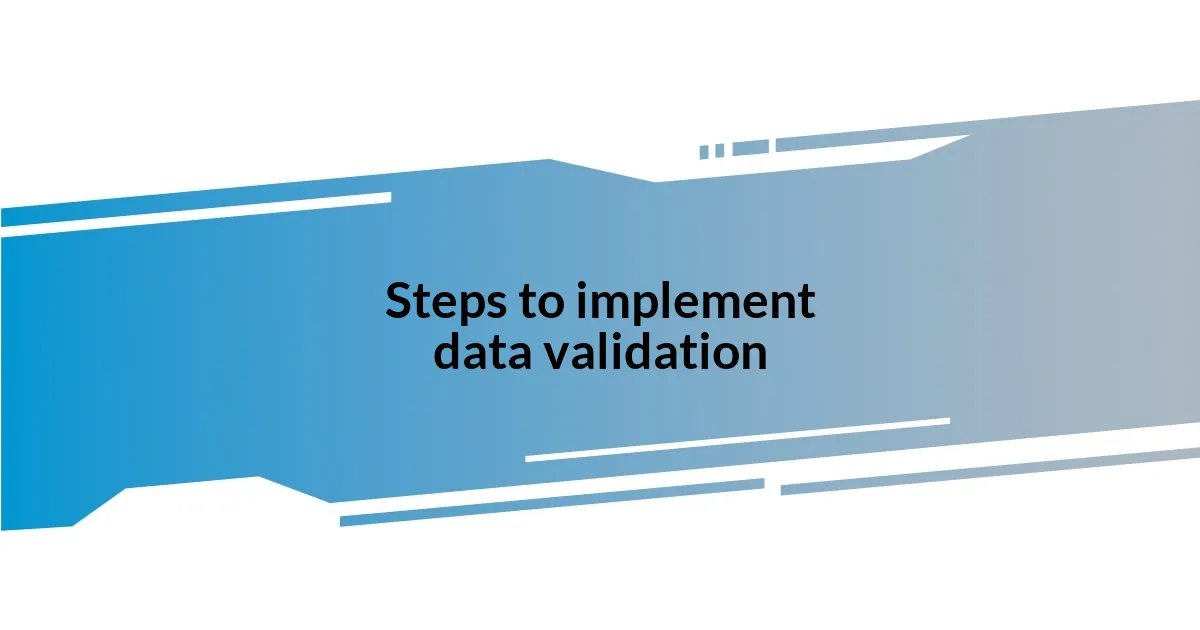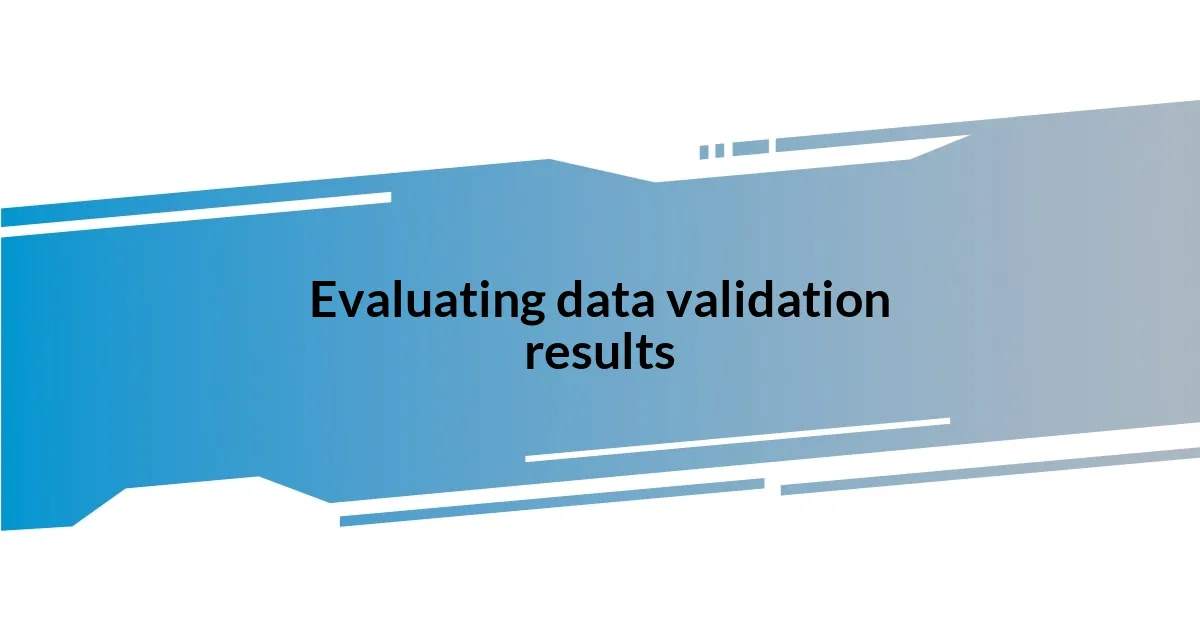Key takeaways:
- Data validation is essential for reliable data management, preventing errors that can cause significant financial and operational issues.
- Various techniques like format, range, and presence validation are crucial for ensuring data accuracy and consistency across projects.
- Utilizing tools like Excel, DataCleaner, Talend, and Apache Nifi can streamline the validation process, enhance accuracy, and save time.
- Continuous monitoring and involvement of stakeholders in the validation design process promote data integrity and adapt to changing data requirements.

Understanding data validation importance
Data validation is the cornerstone of reliable data management. I once came across a project where inaccurate data led to misplaced resources, causing not only financial loss but also impacting team morale. It made me realize how critically important it is to ensure that the data we’re working with is sound and trustworthy.
Think about it: how often have you encountered frustrating errors simply because of a small data entry mistake? I remember when a colleague’s rushed input caused confusion in our analysis reports. That experience was a powerful reminder that validating data isn’t just a checkbox task; it’s essential for making informed decisions and achieving project goals.
Moreover, the emotional burden of fixing errors that could have been avoided weighs heavily on any team. It’s not just about accuracy; it’s about instilling confidence in the data we rely on. When you know that the data has been thoroughly validated, it empowers you to take bold steps forward instead of second-guessing your foundational information. Have you ever thought about how much smoother your workflow could be with effective data validation? I assure you, it transforms daily operations into a more harmonious process.

Types of data validation techniques
When exploring types of data validation techniques, I find it fascinating how various methods can fit different scenarios. For instance, I once had to sort through a mountain of survey data, and applying format validation was a lifesaver. This technique ensures that entries match specified formats, like ensuring dates follow the MM/DD/YYYY structure. It removed a lot of the noise quickly and allowed me to focus on deeper analysis.
Here are some key data validation techniques:
- Format Validation: Checks if data is in the correct format.
- Range Validation: Ensures values fall within a specific range.
- Consistency Validation: Confirms that data is consistent across different sources.
- Uniqueness Validation: Ensures that data entries are unique when required, which is vital for IDs.
- Presence Validation: Checks that required fields are filled in, so no crucial information is missed.
Each of these techniques plays a role in creating a robust data environment. I remember a project where I implemented presence validation, and it highlighted missing information that could have skewed our analysis significantly. Seeing that validation process unfold gave me a sense of relief, knowing we were on the right track.

Tools for effective data validation
Tools for effective data validation are as crucial as the techniques themselves. Over the years, I’ve discovered that using specialized software not only streamlines the data validation process but also enhances accuracy. For example, I once turned to Excel’s Data Validation feature for a financial project. It allowed me to set rules for inputs; I could enforce dropdowns for categories and restrict values to avoid any erroneous entries. That experience taught me how much time I could save by using tools that automate and enforce standards.
In addition to Excel, there are several other tools that I’ve encountered, each with its unique strengths. DataCleaner is another fantastic option I’ve used, especially for data profiling and cleaning. It provides a visual representation of data quality issues, which can be quite revealing. I remember how it helped our team identify duplicate entries that we were completely unaware of, saving us from potential miscalculations in our final report.
For larger datasets and organizations, Talend and Apache Nifi have become indispensable. They allow more advanced data integration and validation methodologies, enabling teams to handle complex dataflows seamlessly. The first time I integrated Talend into a project, I felt like I had discovered a treasure trove of possibilities. It not only validated the data but also transformed it into a usable format, which was incredibly rewarding.
| Tool | Best Use Case |
|---|---|
| Excel | Simple validation with rules and dropdowns |
| DataCleaner | Data profiling and detecting duplicates |
| Talend | Advanced data integration and validation |
| Apache Nifi | Complex data flow management |

Steps to implement data validation
To implement data validation effectively, it’s essential to begin with a thorough assessment of your data requirements. Reflecting on a past project, I realized the significance of clearly defining what constitutes valid data before even diving into the validation process. This step not only outlines the criteria but also sets expectations, which can significantly guide the entire validation strategy.
Next, I recommend choosing the appropriate validation techniques based on the data type and purpose. For instance, I once faced a situation where using range validation for age data proved critical. By establishing boundaries—like ages between 18 and 65—I avoided data entry errors that could have led to skewed insights. Can you imagine the headaches that might arise from such discrepancies? It’s amazing how setting these parameters can enhance data reliability.
Finally, it’s essential to continuously monitor and adjust your validation processes as data evolves. This is something I often remind myself of; even great validation practices can become outdated. During one project, I had to revisit an old dataset that lacked sufficient uniqueness validation, and it was startling to find duplicates slipping through. I learned then that data validation isn’t just a one-time effort—it’s an ongoing commitment to quality.

Common data validation challenges
Common data validation challenges can often feel like navigating a minefield. One significant hurdle I’ve encountered is dealing with inconsistent data formats. Have you ever faced a situation where some dates are entered as MM/DD/YYYY while others use DD/MM/YYYY? It can be incredibly frustrating! In a project I once handled, this inconsistency led to days of backtracking to ensure everything was accurate, showing just how vital it is to establish standard formats upfront.
Another challenge that arises frequently is human error during data entry. I once worked with a team where a few team members accidentally misspelled customer names, which snowballed into major discrepancies in our data reports. Can you imagine compiling a report, only to find out that key information was fundamentally incorrect? It’s important to implement validation checks that trigger alerts for unlikely entries—this approach can save teams from lasting headaches and fosters a culture of accuracy.
Lastly, I often see organizations underestimating the importance of comprehensive validation rules. In a recent initiative, I realized that merely checking for duplicates wasn’t enough. We needed to set criteria for acceptable ranges, formats, and even relationships between data points. This realization was a game changer, as it dawned on me how a little extra effort upfront could prevent a flood of errors later. Have you ever felt overwhelmed by the volume of data? Implementing thorough validation rules can turn that stress into a manageable task, ensuring you always stay one step ahead.

Best practices for data validation
When it comes to data validation, establishing clear and consistent input standards is paramount. Take it from me—after working on a project where we received user data in multiple varying formats, there were moments when I doubted our dataset’s integrity. By implementing strict format guidelines from the outset, like the format for phone numbers (e.g., (123) 456-7890), I not only saved countless hours correcting errors later but also boosted the overall confidence in our data accuracy.
Another best practice I strongly advocate for is involving stakeholders in the validation design process. I recall a time when feedback from the sales team led to the inclusion of custom validation rules for customer feedback data. Their insights highlighted unique criteria I hadn’t considered, which made the validation process more effective. Isn’t it amazing how collaboration can unveil blind spots? Engaging the team not only fosters ownership but also ensures that the validation rules cater to real-world scenarios.
Lastly, embedding automated validation into your workflow can make a significant difference. I once implemented real-time checks during a data upload process; this allowed us to catch errors instantly rather than retroactively. Can you imagine the relief when we avoided late-stage surprises? Automation minimizes human error and keeps the data clean, ensuring that what you work with is both reliable and relevant.

Evaluating data validation results
Evaluating the results of data validation is a critical step that often gets overlooked. I remember the first time I dug into validation results; it was like peeling an onion—layer after layer of insights emerged. Each discrepancy not only highlighted where I went wrong but also showed me the nuances in data entry practices. Isn’t it interesting how a simple error can reveal larger issues in data collection methods?
As I analyze validation results, I take a moment to categorize the errors into groups: format issues, outliers, and missing data. This organization helps me understand patterns and address root causes effectively. For instance, I once noticed a recurring issue with geographical data entries that strayed outside expected parameters. This triggered a deeper investigation, leading to the discovery of a flawed integration with our mapping tool. Have you ever encountered an unexpected pattern that shifted your entire perspective on data quality?
Furthermore, I always ask myself how these evaluation results can inform future data processes. Reflecting on my findings from validation efforts, I often implement feedback loops that prompt continuous improvement. Recently, I shared insights from evaluation results with my team, leading us to revise our data entry procedures. It’s rewarding to see that what once seemed like a tedious task has transformed into a proactive strategy. How do you leverage your validation results to drive future data integrity efforts?